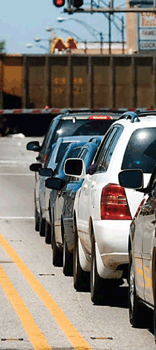In case you missed it, last week’s Talking Transit e-newsletter focused on the FREIGHT Act – which, true to its name, is all about Focusing Resources, Economic Investment and Guidance to Help [Freight] Transportation (FREIGHT – get it?)
Here in metropolitan Chicago and northwest Indiana, a region criss-crossed by seven of the nation’s eight Class I railroads, we know well the challenges our communities, economic well-being, and entire transportation system face because the U.S. does not have a strategy for coordinating freight goals and investments.

As it currently stands, there is no dedicated federal transportation money to help states or regions improve operations along freight corridors or at intermodal hubs. Coordination with commuter rail services that share tracks with freight – such as Metra regionally and Amtrak nationally – is more difficult than it should be, causing bottlenecks and delays not only on freight and commuter tracks, but also for drivers in communities where trains cross busy thoroughfares. And although U.S. freight railroads should be commended for investing more than $460 billion over the past 30 years in rail infrastructure maintenance and improvements, they’ve done so without the guidance of a national freight policy.
The FREIGHT Act is an opportunity to change all that. Introduced in late July in the Senate and in the House a week later, the bill would create a National Freight Strategic Plan and a permanent Office of Freight Planning and Development within the U.S. Dept. of Transportation. It would dedicate funds to reduce freight delays and increase reliability, provide a roadmap for investments, establish goals to reduce emissions and air quality impacts and improve energy use, and promote public-private partnerships toward safer and more efficient freight rail movement.
As a recent Streetsblog post pointed out:
“The bill focuses on areas known as ‘connectors,’ said Kathryn Phillips of the Environmental Defense Fund. ‘All the literature and studies say it’s the connector areas, the hubs, where you have the most congestion and environmental impacts.’ The bill calls for troubleshooting at these bottlenecks, where products are transferred ‘from boat to truck to another truck to rail’ and everything gets bogged down. Trucks get stuck in traffic; trains sit on the tracks; ships idle at port.”
And it’s not just communities that suffer – so, too, does metropolitan Chicago’s ability to maintain our position as a world-class freight hub. Our nearest international competitor Canada has invested $2 billion in a national freight strategy, and other U.S. regions are nipping at our heels. With a focus on connectors, the FREIGHT Act should position metropolitan Chicago favorably for much-needed investments that realize CREATE’s planned improvements.
It’s expected that the FREIGHT Act will be folded into the larger national transportation authorization bill in the House – a good move, despite the slow pace at which that legislation is moving. Unlocking freight needs to be a major piece of the nation’s transportation policy, and this legislation appears to be a good start.